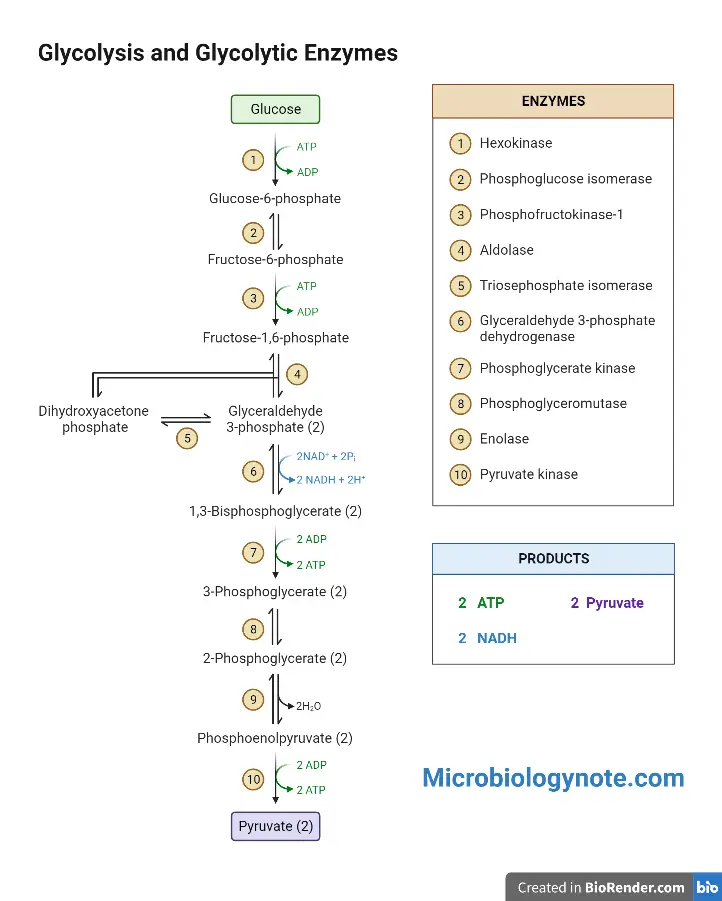Table of Contents
What is Glycolysis?
- Glycolysis is a fundamental metabolic pathway that plays a pivotal role in the cellular utilization of glucose. Scientifically defined, glycolysis is a series of enzymatic reactions that lead to the conversion of glucose, a six-carbon sugar molecule, into two molecules of pyruvic acid, each containing three carbons. This process occurs under aerobic conditions. However, in the absence of oxygen, the end product is lactate. A noteworthy aspect of glycolysis is its ability to produce adenosine triphosphate (ATP), the primary energy currency of the cell.
- The significance of glycolysis extends beyond mere glucose breakdown. It serves as the primary source of energy for many cells, emphasizing its universal importance in cellular metabolism. As glucose undergoes catabolism through the glycolytic pathway, it not only yields pyruvate but also results in the generation of 4 ATP molecules, with a net gain of 2 ATPs, and 2 molecules of NADH, a crucial coenzyme involved in various cellular reactions.
- This metabolic pathway predominantly takes place in the cytoplasm of cells, irrespective of whether they are prokaryotic or eukaryotic. The intricate series of reactions involved in glycolysis were elucidated by scientists Gustav Embden, Otto Meyerhof, and Jakub Karol Parnas. In recognition of their contributions, glycolysis is often referred to as the Embden-Meyerhof-Parnas (EMP) pathway.
- In the broader context of cellular respiration, glycolysis is the initial step that facilitates the breakdown of nutrients, leading to the production of simpler forms of carbohydrates, proteins, and lipids. These compounds subsequently undergo further degradation, culminating in the generation of the energy essential for the sustenance of organisms. In essence, glycolysis is a cornerstone of bioenergetics, underscoring its vital role in life processes.
Glycolysis 10 Steps
Glycolysis is a central metabolic pathway that facilitates the breakdown of glucose into pyruvate through a series of enzymatic reactions. This process is methodically organized into ten distinct steps, divided into two primary phases: the Preparatory phase and the Payoff phase.

Preparatory Phase:
- Glucose Phosphorylation: Initiated by the enzyme hexokinase, glucose undergoes phosphorylation, utilizing an ATP molecule, resulting in glucose 6-phosphate. This reaction is facilitated by the presence of Mg2+ ions.
- Isomerization to Fructose 6-Phosphate: The enzyme phosphohexose isomerase, in the presence of Mg2+, catalyzes the transformation of glucose 6-phosphate into fructose 6-phosphate through a reversible isomerization process.
- Formation of Fructose 1,6-Bisphosphate: The enzyme phosphofructokinase-1 (PFK-1) mediates the phosphorylation of fructose 6-phosphate, consuming another ATP molecule, to produce fructose 1,6-bisphosphate.
- Cleavage into Triose Phosphates: Aldolase facilitates the splitting of fructose 1,6-bisphosphate into two triose phosphates: glyceraldehyde 3-phosphate and dihydroxyacetone phosphate.
- Triose Phosphate Interconversion: The enzyme triose phosphate isomerase swiftly and reversibly converts dihydroxyacetone phosphate into glyceraldehyde 3-phosphate.
Payoff Phase:
- Oxidative Phosphorylation: Glyceraldehyde 3-phosphate is oxidized to 1,3-bisphosphoglycerate, producing NADH in the process. This reaction is orchestrated by the enzyme glyceraldehyde 3-phosphate dehydrogenase.
- ATP Generation: The enzyme phosphoglycerate kinase transfers a high-energy phosphoryl group from 1,3-bisphosphoglycerate to ADP, resulting in the formation of ATP and 3-phosphoglycerate.
- Phosphoryl Group Relocation: Phosphoglycerate mutase, requiring Mg2+ ions, shifts the phosphoryl group in 3-phosphoglycerate to produce 2-phosphoglycerate.
- Dehydration to Phosphoenolpyruvate: The enzyme enolase catalyzes the dehydration of 2-phosphoglycerate, leading to the formation of phosphoenolpyruvate.
- Final ATP Production: In the concluding step, pyruvate kinase facilitates the transfer of a phosphoryl group from phosphoenolpyruvate to ADP, yielding ATP and pyruvate.
In summary, glycolysis is a meticulously coordinated sequence of reactions that efficiently metabolizes glucose to produce energy in the form of ATP, playing a pivotal role in cellular energy homeostasis.
